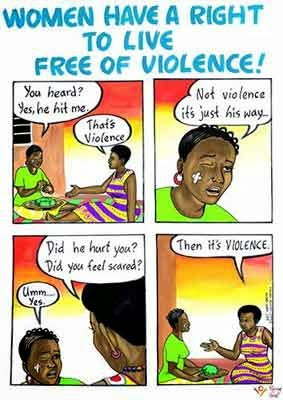Because they are human beings
Violence against women is perhaps the most shameful human rights violation, and it is perhaps the most pervasive. It knows no boundaries of geography, culture or wealth. As long as it continues, we cannot claim to be making real progress towards equality, development and peace.” Kofi Annan, Former UN Secretary-General.Today is the international day on elimination of all forms of violence against women. It also marks the beginning of the 16 days of activism against Gender Based Violence in the world. The campaigns goes for 16 days and ends on 10th December which is the international Human Rights day. This campaign aims to put a focus on violence perpetrated against women and girls. There are other days in between that are marked as well including the International Women Human Rights Defenders Day,(29th Nov,) World AIDS day (Dec 1) international Day of disabled persons (Dec 3) Montreal Massacre (Dec 6), when 14 female engineering
students were massacred.
When discussing issues of violence against women, there is often a justification given usually from a relationship perspective. “Our mothers, sisters...” etc are used to put the point across. This is good as it reminds many that women are not an abstract idea but persons we relate with, in our daily lives. However this narrative often misses the most key point, that women are human beings! It is a basic as that. The discussion on “are women rights human rights” has gone on for long. Why even speak about women’s rights yet they are human? Essentially yes, there is no need to separate women rights from human rights. However in practice, women’s issues are often forgotten in the overall picture. The rights of women are often curtailed due to the social and cultural beliefs and practices which limit how much freedom women should have.
In my view, the tragedy of gender based violence against women has not fully been appreciated. When we get some tragedy like a bombing or accident there is a lot of focus, yet so many women are violated and others die each day yet this is not treated as a global crisis.
Some figures from the United Nations website illustrate this:
• 35% of women and girls globally experience some form of physical and or sexual violence in their lifetime with up to seven in ten women facing this abuse in some countries.
• It is estimated that up to 30 million girls under the age of 15 remain at risk from FGM/C, and more than 130 million girls and women have undergone the procedure worldwide.
• Worldwide, more than 700 million women alive today were married as children, 250 million of whom were married before the age of 15. Girls who marry before the age of 18 are less likely to complete their education and more likely to experience domestic violence and complications in childbirth.
• The costs and consequence of violence against women last for generations. (http://www.un.org/en/events/endviolenceday/ )
This is a global tragedy. The violence is perpetrated due to the power differences where most of the societies are patriarchal with male dominance. In majority of the cases, the perpetrators are men while women form over 80% of survivors of gender based violence.
Recently in Kenya we experienced yet again the public stripping of women in the streets. The discussions that went around that as women and a good number of supportive men mobilized against this were disheartening. The campaign “My Dress My Choice” was started since the excuse for the violence was said to be that women were wearing ‘indecent’ clothes. The discussion went from the violation to justifications with the “nudity” tag put on this. While even the constitution of Kenya recognizes the right to dress, some few men felt that this was within their mandate to regulate. That was the public debate. In none of the cases were the women walking around nude, but the perpetrators undressed them and left them nude while violating and stealing from them. However, the reality is that this was never about dressing but control, power and violence. Some of the survivors of these atrocities were interviewed. It emerged that in all cases it was ‘non-cooperation’ to other forms of violence that led to this. In one case the lady was asking for her rightful payment after selling some eggs and the man who had eaten the eggs started hurling verbal assaults. She was accosted as she tried to leave the venue. In another case the lady had refused to respond to verbal taunting and the perpetrator could not take this and it became a mob justice.
Some of the debates left one speechless wondering if women are real human beings, citizens of this country. The bottom line is that women have a right to live free of violence because they are human beings.
Violence free environment, is everyone's right.

Comments
Post a Comment